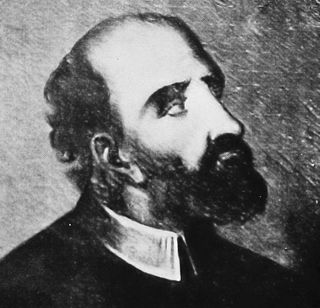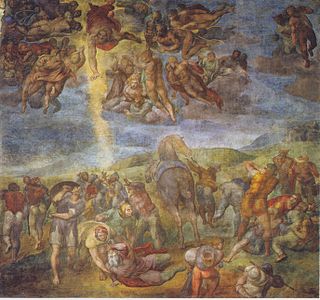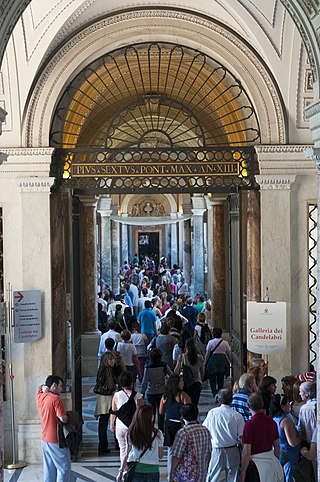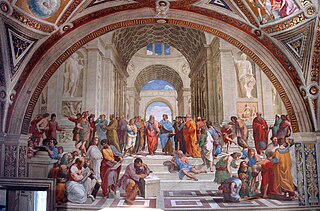Related Research Articles

The Sistine Chapel is a chapel in the Apostolic Palace, the pope's official residence in Vatican City. Originally known as the Cappella Magna, the chapel takes its name from Pope Sixtus IV, who had it built between 1473 and 1481. Since that time, the chapel has served as a place of both religious and functionary papal activity. Today, it is the site of the papal conclave, the process by which a new pope is selected. The fame of the Sistine Chapel lies mainly in the frescoes that decorate the interior, most particularly the Sistine Chapel ceiling and The Last Judgment, both by Michelangelo.

A papal coronation is the formal ceremony of the placing of the papal tiara on a newly elected pope. The first recorded papal coronation was of Pope Nicholas I in 858. The most recent was the 1963 coronation of Paul VI, who soon afterwards abandoned the practice of wearing the tiara. To date, none of his successors have used the tiara, and their papal inauguration celebrations have included no coronation ceremony, although any future pope may elect to restore the use of the tiara at any point during his pontificate.

Giuseppe Ottavio Pitoni was an Italian organist and composer. He became one of the leading musicians in Rome during the late Baroque era, the first half of the 18th century.

The Apostolic Palace is the official residence of the pope, the head of the Catholic Church, located in Vatican City. It is also known as the Papal Palace, the Palace of the Vatican and the Vatican Palace. The Vatican itself refers to the building as the Palace of Sixtus V, in honor of Pope Sixtus V, who built most of the present form of the palace.

Alessandro Moreschi was an Italian chorister of the late 19th century and the only castrato to make solo recordings.

Giovanni Animuccia was an Italian composer of the Renaissance who was involved in the heart of Rome's liturgical musical life. He was one of Giovanni Pierluigi da Palestrina's most important predecessors and possibly his mentor. As maestro di capella of St Philip Neri's Oratory and the Capella Giulia at St Peter's, he was composing music at the very center of the Roman Catholic Church, during the turbulent reforms of the Counter-Reformation and as part of the new movements that began to flourish around the middle of the century. His music reflects these changes.

A Papal Mass is the Solemn Pontifical High Mass celebrated by the Pope. It is celebrated on such occasions as a papal coronation, an ex cathedra pronouncement, the canonization of a saint, on Easter or Christmas or other major feast days.

The Sistine Chapel Choir, as it is generally called in English, or officially the Coro della Cappella Musicale Pontificia Sistina in Italian, is the Pope's personal choir. It performs at papal functions in the Sistine Chapel and in any other church in Rome where the Pope is officiating, including St. Peter's Basilica. One of the oldest choirs in the world, it was constituted as the Pope's personal choir by Pope Sixtus IV. Although it was established in the late 15th century, its roots go back to the 4th century and the reign of Pope Sylvester I.
The papal household or pontifical household, called until 1968 the Papal Court, consists of dignitaries who assist the pope in carrying out particular ceremonies of either a religious or a civil character.

The Cappella Paolina is a chapel in the Apostolic Palace, Vatican City. It is separated from the Sistine Chapel by the Sala Regia. It is not on any of the regular tourist itineraries.
Annibale Zoilo was an Italian composer and singer of the late Renaissance Roman School. He was a contemporary of Palestrina, writing music in a closely related style, and was a prominent composer and choir director in Rome in the late 16th century.

The main Tourism in Vatican City are focused in religious tourism and city tourism, including the visit to the Basilica of St. Peter, Saint Peter's Square, the Vatican Museums, the Sistine Chapel, and the Raphael Rooms.Vatican City is quarter of a square mile (0.44 km2) in area, is a popular destination for tourists, especially Catholics wishing to see the Pope or to celebrate their faith. The largest numbers of pilgrims visit Vatican City at special moments in the liturgical year, such as Christmas or Easter, or during important periods such as the proclamation of a holy year or the funeral and election of a pope.

The Sala Regia is a state hall in the Apostolic Palace in Vatican City.

Cesare Nebbia (c.1536–c.1614) was an Italian painter from Orvieto who painted in a Mannerist style.

Pope Julius II, commissioned a series of highly influential art and architecture projects in the Vatican. The painting of the Sistine Chapel ceiling by Michelangelo and of various rooms by Raphael in the Apostolic Palace are considered among the masterworks that mark the High Renaissance in Rome. His decision to rebuild St Peter's led to the construction of the present basilica.

St. George's Basilica or the Basilica and Collegiate Parish Church of Saint George, also simply known as San Ġorġ in Maltese, is a historic Baroque church situated in the middle of Gozo, the second largest island in the Maltese archipelago, and is surrounded by a maze of old narrow streets and alleys. Today's basilica was built between 1672 and 1678.
This is an index of Vatican City–related topics.

The Renaissance in Rome occupied a period from the mid-15th to the mid-16th centuries, a period which spawned such masters as Michelangelo and Raphael, who left an indelible mark on Western figurative art. The city had been a magnet for artists wishing to study its classical ruins since the early 15th century. A revived interest in the Classics brought about the first archaeological study of Roman remains by the architect Filippo Brunelleschi and the sculptor Donatello. This inspired a corresponding classicism in painting and sculpture, which manifested itself in the paintings of Masaccio and Uccello. Pisanello and his assistants also frequently took inspiration from ancient remains, but their approach was essentially cataloguing, acquiring a repertoire of models to be exploited later.

Domenico Bartolucci was an Italian cardinal of the Catholic Church. He was the former director of the Sistine Chapel Choir and the Accademia Nazionale di Santa Cecilia, and was recognized in the field of music both as a director and a prolific composer. Considered among the most authoritative interpreters of Giovanni Pierluigi da Palestrina, Bartolucci led the Sistine Chapel Choir in performances worldwide, and also directed numerous concerts with the Choir of the Academy of Santa Cecilia, including a tour of the former Soviet Union.
François Roussel, also known as Francesco Rosselli, was a French Renaissance composer of both sacred and secular music. His works included motets, masses, madrigals, and songs.
References
- ↑ For the history of the Vatican Chapter, see Pope Benedict XVI, address to members of the Vatican Chapter, Clementine Hall, 8 October 2007.
- ↑ See Cappella Giulia, Wikipedia (Italian) and Fondazione Pro Musica e Arte Sacra, IV Festival Internazionale di Musica e Arte Sacra, Rome (23–26 November 2005), program Archived 19 July 2011 at the Wayback Machine and artist Archived 19 July 2011 at the Wayback Machine notes.
- ↑ "Sistine Choir," Catholic Encyclopedia (1913).
- ↑ Sistine Chapel Choir and H. Bewerunge, "Palestrina and Orlando di Lasso," The Irish Ecclesiastical Record, p. 1092.
- ↑ Sandro Magister, "A New Musical Season Opens at the Vatican – And Here's the Program," L'Espresso, 18 October 2007; cf. Jeffrey Tucker, "Music at St. Peter's: The Transformation" (interview with Rev. Pierre Paul), New Liturgical Movement, 10 August 2009.
- ↑ See Cappella Giulia, Wikipedia (Italian).